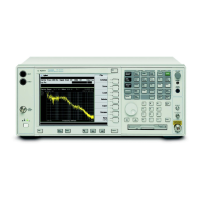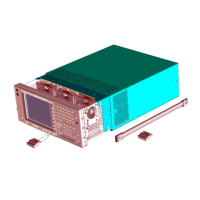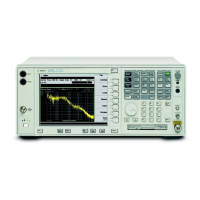166 Chapter 2
Front-Panel Key Reference
Peak Search
For example, N dB Points can be used to measure the 3 dB bandwidth
of a filter in a transmission test with the tracking generator. The
default value is –3 dB. Possible values range from
−
1.00 dB to
−
80.00 dB. You can enter values to a resolution of 0.01 dB using the
numeric key pad, 0.1 dB using the knob, or 10 dB using the step keys.
The measured signal cannot have more than one peak that is greater
than or equal to N dB. A signal must be greater than the peak
excursion above the peak threshold to be identified. The setting for
peak excursion may be increased from the –6 dB default value so that
noise will not be identified as signals. Increasing the value too much
may cause a smaller signal to be missed or misinterpreted as part of a
larger signal. The amplitude scale may be either linear or logarithmic.
The N dB function follows the active marker. If you turn on a marker
after N dB Points has been activated, the arrows will follow that
marker. If the marker associated with N dB Points moves, the arrows
will move with the marker unless there is no data N dB below the
marker.
Key Access:
Search, More
Search Criteria
Accesses the following menu keys:
Key access:
Search, More
Peak Excursion
Sets the minimum amplitude variation of signals that
the marker can identify as a peak. If a value of 10 dB is
selected, the marker moves only to peaks that rise and
fall more than 10 dB above the peak threshold value.
Pressing
Preset (when Preset Type is set to Factory) or
turning on power resets the excursion to 6 dB and the
threshold to 90 dB below the reference level.
NOTE Two signal peaks, which are so close together that the amplitude drop
between them is less than the peak-excursion value, are not recognized
as two peaks. A signal peak is recognized only if it has a peak excursion
drop above the noise floor, on both sides of the signal.
When the peak excursion value is 6 dB or higher, the
marker-peaking functions do not recognize signals less
than the peak excursion value above the noise floor. To
correct this, when measuring signals near the noise
floor, the excursion value can be reduced even further.
To prevent the marker from identifying noise as
signals, reduce the noise floor variance to a value less
than the peak-excursion value by reducing the video
bandwidth or by using video averaging.
Key access:
Peak Search, More, Search Criteria

